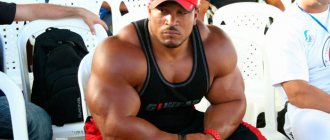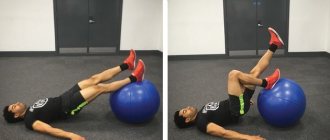Successful training at home or in the gym always means discipline and strict adherence to a well-designed plan. It is impossible to exercise unsystematically, choosing exercises at random. This approach not only does not give any positive results, but often leads to unpleasant consequences in the form of various injuries to muscles, joints and ligaments.
A weekly training program is the minimum plan that allows you to qualitatively include fitness or hard disciplines in your life. Only by following the rules can you lose weight well and form a beautiful muscle profile. There are a few simple tips that will help you create a great program.
Determining the goal of training
The very first step is setting a goal. Getting an answer to the question: “Why do you need to go to the gym or exercise at home?” We bring to your attention several main reasons why a person includes sports in his life:
- Losing weight (fat burning).
- Drying (working out muscle relief).
- Gaining muscle mass.
- Increasing strength and endurance (as well as separately).
The most common choice, of course, is to fight extra pounds and increase muscle mass. In both cases, you need not only a good training program, but also a balanced, healthy diet. To gain muscle, it should be high-calorie, and for fat burning - with a reduced daily calorie content.
What should be the number of repetitions
I will make a separate article on this topic. Now I will only say the main points. If your goal is to gain muscle mass, you should almost always do 6-12 reps per set. But it must be said that the number of repetitions is not so important!
The most important thing is to take into account the time the muscle is under load! The load should lead to muscle failure within 10-30 seconds.
Those. if it is, for example, a large muscle such as the quadriceps, then muscle failure will occur in the desired interval of 10-30 seconds just when performing 6-12 repetitions, but if it is a muscle that makes movements in a small amplitude, such as the calf, then you should do 15-20 repetitions. I think this is clear.
The smaller the range of motion of the muscle being trained, the more repetitions should be done to achieve muscle failure in the range of 10-30 seconds.
Selecting exercises: sorting by directions
There are a lot of exercises. And if you include various sports equipment in your work, there will be even more of them. When drawing up a program for the week, it is important to clearly determine what format of exercises you need. They are all divided into several categories:
- Aerobic. Otherwise called cardio. Energy is provided through a chemical reaction with glycogen in the presence of oxygen.
- Anaerobic. These are strength exercises. Muscles contract due to the use of creatine phosphate and glycogen, but without the participation of oxygen. As a result, lactic acid is formed.
- Complex. A combination of aerobic and anaerobic exercise.
Interesting fact. In gyms, the emphasis is on strength (anaerobic) training. Exercises are performed using various weights, weights and other equipment. They help build muscle, but are not suitable for weight loss.
If you are planning to lose a couple of extra pounds, then the basis of the program should be aerobic exercise. In a fitness center, the following are suitable for performing them: jump ropes, steppers, exercise bikes, and a treadmill.
Warm-up is required
During the first 5-10 minutes before starting the training, you need to warm up. It helps minimize the risk of injury. This is especially important for those who have a history of sports injuries. The warm-up begins with light cardio, then moves on to the joints.
To prepare for your workout, you can perform several basic exercises with minimal weight.
Suitable for warm-up:
- jumping rope;
- running on a treadmill;
- pushups;
- weighted squats;
- pull-ups on the horizontal bar.
Important: the warm-up should not exhaust you - it only prepares you for the basic load.
Order of exercises
It is very important to maintain consistency when performing exercises. Chaos in the program is of no use - it will never lead to progress, but will only contribute to internal disturbances, which are not always easy to eliminate.
If a training program compiled by a professional involves doing a heavy exercise first, that’s where you should start. Otherwise, the athlete simply will not have any strength left by the end of the lesson. It is important to strictly follow the recommendations. They make training much more effective.
- Experienced athletes with high physical activity are recommended to divide their training days in a split format. This means that a separate muscle group is assigned to a certain day. For example, on Monday we work with the back, and on Wednesday with the legs, etc.
- For beginners, fullbadi programs are recommended, aimed at working out the whole body. The difference with split training is only in the intensity of the process, as well as the alternation of easy/difficult days.
Mass training program for men in the gym
Day 1 (Chest, biceps)
- Dumbbell press on a horizontal bench 3 x 10-12.
- Barbell press at a 45 degree angle 3 x 10-12.
- Reduction of arms in a crossover at an angle of 30 degrees 3 x 10-12.
- Biceps with a z-bar with a wide grip 3 x 10-12.
- Seated arm curl with hammer dumbbells 3 x 10-12.
- Press: crunches on an incline bench 3 x 15-20.
- Press: leg raises on uneven bars 3 x 15-20.
Day 2 (Back, legs)
- Wide grip pull-ups 3 x 10-12.
- T-bar 3 x 10-12.
- Horizontal thrust 3 x 10-12.
- Hyperextension with weight 3 x 10-12.
- Smith machine squats 3 x 10-12.
- Seated leg extension 3 x 10-12.
- Leg bending in the simulator 3 x 10-12.
Day 3 (Shoulders, triceps)
- Bench press in Smith from behind the head 3 x 10-12.
- Delta machine 3 x 10-12.
- Shrugs with a barbell 3 x 10-12.
- Dumbbell swings at an angle of 45 degrees (rear deltoid) 3 x 10-12.
- Close grip barbell press 3 x 10-12.
- French bench press 3 x 10-12.
- Dumbbell extension from behind the head while sitting 3 x 10-12.
- Press: repeat day 1.
Ways and methods of performing strength exercises
For beginner athletes, it is best to stick to a traditional strength-building and muscle-building regimen. In this case, regular sets are suitable - the rest between elements and the actual approaches is from 2 to 6 minutes. For experienced athletes, more complex methods of performing exercises open up:
- Drop sets. During the training process, the athlete gradually reduces the working weights in the exercise. Reducing each time by about 25%. This way we slowly reach failure. Rest between sets is minimal.
- Supersets. They involve working out certain muscle groups (identical or opposite) by sequentially performing various exercises (two or more). There is no rest between approaches.
- Trisets. One of the varieties of a superset, which involves pumping muscles not with two, but with three exercises performed in succession. There is also no rest.
Interesting fact. Using various methods makes it possible to always keep muscles in good shape, avoiding unpleasant stagnation and the plateau effect.
Recommendations to follow during classes
- Take care of free space for training. In tight spaces, the risk of injury increases many times over.
- Special sports shoes and clothing will also help to avoid injury. Pants and a T-shirt should not be too loose or, on the contrary, too tight. The purpose of sportswear is to give freedom of movement, and not to interfere with training. Sneakers should be the right size and of good quality.
- If you feel unwell during exercise, immediately stop doing the exercises and go to rest. Don't confuse fatigue with feeling unwell. It’s normal to be overtired, sweat profusely, and feel hot in your muscles. You should worry when your vision gets dark, you hear ringing in your ears, coordination of movements is impaired, and the pulse beat is felt at the root of your tongue. In such a situation, you need to urgently stop training.
- Exercising during illness is contraindicated. This is one of the basic rules. In this case, the situation largely depends on the person’s well-being. If an athlete experiences only mild symptoms of a cold, nothing prevents him from training. If you have severe symptoms of the disease, you should not exercise.
To benefit from classes and not harm yourself, follow these rules exactly!
Muscle recovery
The concept of muscle recovery includes not only the renewal of energy reserves, but also the reconstruction of its cells. To conduct effective training, athletes use two rules:
- one muscle group is trained one day a week;
- the pause between workouts ranges from 48 to 96 hours.
This break allows the body to produce glycogen to replenish lost reserves. Cell restoration occurs within about two weeks - it depends on the characteristics of the body. The training program for 3 days a week provides not only intensive training, but also proper rest.
Content
- How long to train?
- Warm-up
- How to create a training program: basic principles
- Basic exercises
- How many approaches should you do?
- How many repetitions should I do?
- How long to rest between sets?
- How to choose a working weight?
- How to calculate the duration of a workout?
- A training program with alternating approaches and reducing rest between them.
- Circuit training program
- Cool down and its role in creating a training program
- Basic rules for creating a training program










